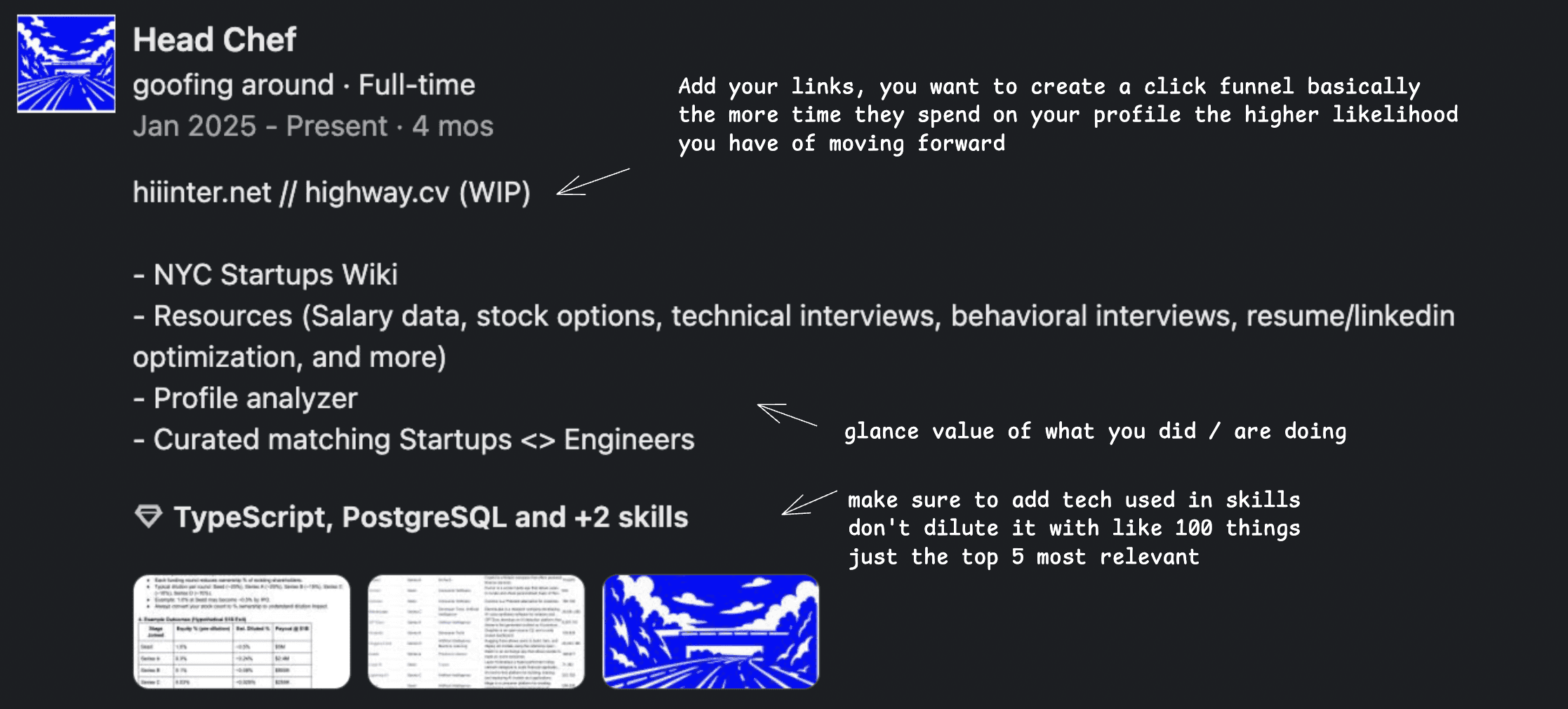How to Stand Out as a Software Engineer: Resume, LinkedIn, Portfolio, and More
Tl;dr
Recruiters (or founders / hiring managers if they don't have a recruiter) scan thousands of profiles—your goal is to signal fit instantly. Make it visually obvious that you align on tech stack, domain, and industry. LinkedIn matters more than your resume. Use it as a portfolio hub with images, links, and company branding. Especially critical if you don't have name-brand credentials.
Why LinkedIn > Resume
Recruiters usually check your LinkedIn first even if they have your resume —it's faster to parse, includes visual signals (company logos, images, links). If your resume is great but your LinkedIn is bare, you're missing the primary opportunity to make a strong impression.
An even better option is a great portfolio but that can take time, just in case though here are some crazy portfolios:
Key advantages:
- Visual credibility: Logos and banners boost recognition.
- Linking to proof: Link to GitHub, portfolio sites, writeups, and features.
- Extended content: Highlight auxiliary articles, media, content and more.
Bonus: Add "proof-of-work" imagery to your LinkedIn experience section.
- Screenshots of projects
- Decks or demos
- Media appearances or blog posts


Core Filtering Criteria
Recruiters use Boolean search to find candidates, the same applies when they look at inbound candidates. You need to match 3 main vectors:
Tech Stack Fit
- Use keywords in your title and summary.
- Make it easy to CTRL+F: (TypeScript, React, Next.js, etc.)
- Don't bog down your resume / portfolio with non high signal words e.g. if you're applying for a frontend role it doesn't make sense to include Java and spring in your skills section just because you used it years ago.
Domain Experience
- List specific projects: payments, video, infra, realtime.
- Add descriptions like: "Built Stripe integration", "scaled WebSocket infra."
Industry Familiarity
- Mention if you've worked at seed-stage startups, Series A, or scaled companies.
- If the companies or projects you've worked on are in a related industry e.g. consumer, fintech etc make sure you're providing context. Assume whoevers looking at your profile knows nothing about your company.
What if You Don't Have Ascribed Credibility?
Not from FAANG? Didn't go to MIT? No YC badges? You must create your own credibility.
Here's how:
Visual storytelling on LinkedIn
- Post project images with writeups.
- Create a featured section with top links.
Portfolio site
- Keep it clean, mobile-friendly, and fast.
- Include breakdowns of real-world projects (ideally shipped).
- Remove boilerplate e.g. create next app & vercel logo as metadata. Get a domain, don't use x.vercel.app or alternatives.
GitHub profile
- Pin repos that are active and relevant.
- Include READMEs with context, not just code dumps.
- High commit count and commit map does matter to recruiters - they probably won't look at the repos anyways but will look to see if you've been contributing.
Resume Tips (Yes, It Still Matters)
Your resume is a backup signal—not the first one. But when recruiters dig deeper, it should reinforce your story.
Do:
- Keep it 1 page if possible.
- Tailor bullets to highlight impact and stack fit.
- Use action verbs + quantifiable results (Built X using Y for Z users).
Don't:
- List unrelated work experience
- List a bunch of tech you don't really work with and/or that's not relevant to the role
- ^^ for the don't basically just keep in mind that if it's not something that's a high signal for that particular role it is diluting your experience and when you're only getting a glance you want to make sure they see what you want them to see.
What to Post on LinkedIn
- Proof-of-work threads: Short posts about something you built.
- Code breakdowns: Before/after screenshots, architecture diagrams.
- Reflections: What you learned from a failure, tradeoff, or launch.
You don't really have to worry about traction in terms of likes. The biggest value is in having a directory of content that can be looked through. That said if you make great stuff it will get traction.
For getting hired via social platforms your best bet is still posting on X and YouTube but the bar for getting traction is high.
Here are some good examples:
Final Thoughts
Getting noticed as a software engineer is less about credentials and more about clarity. If you can make it instantly obvious that you're a fit, you dramatically increase your chances of getting a look—even at top startups.
Start with this checklist:
- ✅ Tech stack keywords in title and summary
- ✅ Projects described in terms of problems solved
- ✅ Industry cues: early-stage, B2C, infra, etc.
- ✅ Visual content embedded in LinkedIn
- ✅ Portfolio and GitHub with signal, not noise
You don't need to be famous. You just need to be findable—and clearly aligned.
